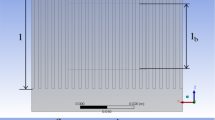Abstract
An experimental study has been carried out to estimate the heat transfer improvement offered by a novel electro-osmotic (EO) heat spreader for microprocessor cooling. The proposed design of the elliptical silicon heat spreader can be fabricated at the back surface of the microprocessor as an integral part. Thus, no extra space may be required. The EO heat spreader developed is 0.6 mm3 in volume and it contains a pair of thin gold film electrodes of approximately 1 μm thickness for applying an external electric field that induces electro-osmotic flow. The inner channel surfaces of the heat spreader are electrically insulated with a thin SiO2 layer to minimize current leakage into the wafer. The EO heat spreader constructed is able to generate a flow rate of 0.2028 μl/min at 2 V/mm. With this heat spreader, the temperature of a heat source may be reduced by up to 4°C without the aid of any external mechanical devices. The heat spreader has the potential to make the temperature uniform, if the heat source is non-uniform in nature.










Similar content being viewed by others
References
Alvarez MD, Merlos A, Santander J, Campabadal F (2000) Optimized technology for the fabrication of piezoresistive pressure sensors. J Micromech Microeng 10:204–208
Arnold AK, Nithiarasu P, Eng PF (2008a) Electro-osmotic flow (eof) in micro-channels. Inst Mech Eng C J Mech Eng Sci 222:753–759
Arnold AK, Nithiarasu P, Tucker PG (2008b) Finite element modelling of electroosmotic flows using unstructured meshes. Int J Numer Methods Heat Fluid Flow 18:67–82
Brask A, Kutter JP, Bruus H (2005) Long term stable electroosmotic pump with ion exchange membrance. Lab Chip 5:730–738
Chen Z, Singh RK (2003) Mechanism of particle deposition on silicon surface during dilute hf cleans. J Electrochem Soc 150:667–672
Eng PF, Nithiarasu P (2009) Numerical investigation of an electro-osmotic flow (eof) based micro-cooling system. Numer Heat Transf Fundam 56:275–292
Eng PF, Nithiarasu P, Guy OJ. Reducing electrical interference in an electro-osmotic cooling system using silicon dioxide. J Micromech Microeng (submitted)
Erickson D, Li D (2003) Three dimensional structure of electroosmotic flow over hetergenous surfaces. J Phys Chem B 107:12212–12220
Fu C, Hung C, Huang H (2006) A novel and simple fabrication method of embedded su8 micro-channels by direct uv lithography. J Phys Conf Ser 34:330–335
Glawdel T, Ren CL (2008) Electroosmotic flow control for living cell analysis in microfluidic pdms chips. Mech Res Commun (in press)
Hierlemann A, Brand O, Hagkeitner C, Baltes H (2003) Microfabrication techniques for chemical/biosensors. Proc IEEE 91:839–863
International Technology Roadmap for Semiconductors (2007) ITRS 2007 edition. http://www.itrs.net/reports.html
Jiang L, Mikkelsen J, Koo JM, Huber D, Yao S, Zhang L, Zhou P, Maveety JG, Prasher R, Santiago JG, Kenny TW, Goodson KE (2002) Closed-loop electroosmotic microchannel cooling system for VLSI circuits. IEEE Trans Compon Packag Technol 25:347–355
Kim MJ, Beskok A, Kihm KD (2002) Electroosmotic driven microchannel flows: A comparative study of microscopic particle image velocimetry measurements and numerical simulations. Exp Fluids 33:170–180
Kim SY, Lee MH, Lee KS (2005) Heat removal by aluminum-foam heat sinks in a multi-air jet impingement. ITCPT 28:142–148
Laser DJ (2005) Design, fabrication, and applications of silicon electroosmotic micropumps. Ph.D. dissertation, Stanford University
Laser DJ, Santiago JG (2004) A review of micropumps. J Micromech Microeng 14:792–795
Laser DJ, Myers AM, Yao SH, Bell KF, Goodson KE, Santiago JG, Kenny TW (2003) Electroosmitc micropumps for integrated circuit thermal management. In: Proceedings of transducers, Boston, MA
Lin CH, Lee GB, Chang BW, Chang GL (2002) A new fabrication process for ultra-thick microfluidic microstructures utilizing su8 photoresist. J Micromech Microeng 12:590–597
Mahajan R, Chiu C, Chrysler G (2006) Cooling a microprocessor chip. Proc IEEE 94:1476–1486
Probstein RF (1989) Physicochemical hydrodynamics. Butterworths, Boston
Singh SP, Nithiarasu P, Eng PF, Lewis RW, Arnold AK (2008) An implicit-explicit solution method for coupled electro-osmotic flows in three dimensions using unstructured meshes. Int J Numer Methods Eng 73:1137–1152
Takamura Y, Onoda H, Inokuchi H, Adachi S, Oki A, Horiike Y (2003) Low voltage electroosmotic pump for stand alone microfluidics devices. Electrophoresis 24:185–192
Tang GY, Yang C, Chai KC, Gong HQ (2004) Numerical analysis of the thermal effect on electroosmotic flow and electroskinetic mass transport in microchannels. Anal Chim Acta 507:27–37
Wang P, Bar Cohen A (2007) On-chip hot spot cooling using silicon thermoelectric microcoolers. J Appl Phys 102:034503
Wu EY, Vollertsen RP, Jammy R, Strong A, Radens C (2002) Leakage current and reliability evaluation of ultra thin reoxidized nitride and comparison with silicon dioxide. In: 40th annual international reliability physics symposium proceeding, pp 255–267
Yao SH, Hertzog DE, Zeng SL, Mikkelsen JC Jr, Santiago JG (2003) Porous glass elecroosmotic pumps: Design and experiments. J Colloid Interface Sci 268:143–153
Zhang HY, Pinjala D, Wong TN, Joshi YK (2005) Development of liquid cooling techniques for flip chip ball grid array packages with high heat flux dissipations. ITCPT 28:127–135
Acknowledgement
This work was partially funded by EPSRC grant D070554.
Author information
Authors and Affiliations
Corresponding author
Rights and permissions
About this article
Cite this article
Eng, P.F., Nithiarasu, P. & Guy, O.J. An experimental study on an electro-osmotic flow-based silicon heat spreader. Microfluid Nanofluid 9, 787–795 (2010). https://doi.org/10.1007/s10404-010-0594-3
Received:
Accepted:
Published:
Issue Date:
DOI: https://doi.org/10.1007/s10404-010-0594-3




